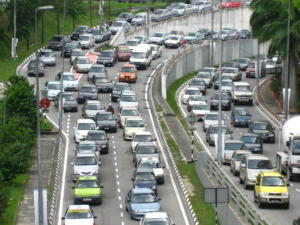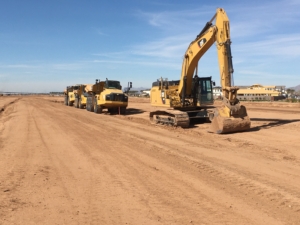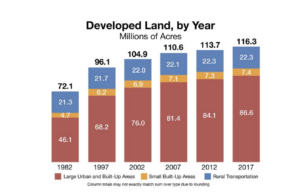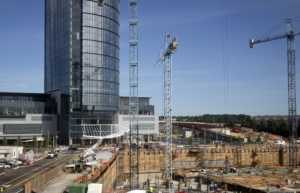Emerging Signs of Grassroots Resistance to Growth
by Christy Shaw
There seem to be encouraging signs that more and more average Americans are speaking out and taking action to oppose uncontrolled growth. Concerned citizens are sounding the alarm that too much growth is doing far more harm than good in their towns, cities and communities.

Who benefits from the congestion that inevitably comes with economic growth?
(CC BY-NC 2.0, lynac)
While there does not yet appear to be a coordinated nationwide coalition of activism, there are definitely increasing signs of grassroots efforts to push back against the all-too common, well-funded, political and mass-media argument that growth is always good.
For far too long, pro-growth donors and their lobbyists have worked very hard to convince the public and their elected representatives at every level of government and position of authority that continual GDP growth is the best measurement of a healthy economy. This continues to be the widely accepted narrative despite the fact that the country is experiencing increasing inequality and environmental degradation.
However, people who live, work and raise families in places where there is excessive growth (especially where drought is causing severe water shortages in the West) tell a different side of the growth story. Residents are concerned about the rate at which too much growth is now destroying the beauty, quality of life, and ecological balance of their areas—the very reasons they moved there to begin with.
Maricopa County, Arizona
Arizona is one of seven states under severe water restrictions due to unrelenting drought conditions. Incredibly, at the same time these states are struggling to agree on the amount of water for which residents, businesses and farmers will compete, city and state elected officials are still issuing building permits to build more housing developments.

Excavation equipment runs wild in Arizona. (CC BY-NC-ND 2.0, Arizona Department of Transportation)
Maricopa County resident and professional nature photographer, Rusty Childress, wrote an op-ed published August 26, 2022, calling for fellow Arizonans to push back against excessive growth by voting pro-growth candidates out of office, emphasizing that “New development will only increase demand for scarce water supplies.”
And, he says:
“…soon [these new homes will] be functionally uninhabitable, once the city of Scottsdale—faced with increasingly dire water supplies of its own—stops hauling water to Rio Verde residents whose wells have run dry at the end of the year.
“The community is a prime example of how unchecked development can strain precious resources, degrade the environment, and ultimately leave residents with little option but to pack up and move elsewhere…
“Town commissioners and zoning board members are the ones who approve new construction permits. They’ll decide whether we stay on our current unsustainable path or whether we’ll change course. Elections for local offices like these might not command the same attention as statewide and national races, but they have an enormous impact on folks’ day-to-day quality of life.”
“Consider that new development has destroyed close to 2,000 square miles of natural habitat and farmland in Arizona since 1982. That represents a 114% increase in developed land over the same period.“
Childress concludes his comments with this irony:
“Many of Arizona’s new residents came to the state for its promise of a high quality of life: sunshine, clear skies, and wide-open spaces. If current trends continue, it’s only a matter of time before those amenities become a thing of the past.”
Utah Population and Environment Council
At least one group of Utah citizens has taken action to inform policymakers and local leaders of the overall need to achieve population stabilization to ensure economic and ecological sustainability for future generations. In 1997, this small group of concerned Utahans formed a coalition to oppose the rapid increase in population growth in the state. In 2016, they established the Utah Population and Environment Council (UPEC), a 501(c)3 nonprofit organization.
The 2020 Census confirmed what Utahans were already seeing: The state had the highest rate of population growth (18.4%) since the previous census. Utah’s way of life is rapidly transforming, and not all of that change is positive or beneficial to residents. UPEC’s mission, then, is “to achieve a sustainable, healthy, and happy human population living in harmony with the natural environment.”

Cumulative growth in area of developed land nationwide, 1982-2017 (Source: NRCS)
To date, UPEC has conducted two research studies, the Utah Ecological Footprint Study, and the Genuine Progress Indicator Study (GPI). The footprint study concluded that:
“Utah is living beyond its ecological means, with consumption of resources exceeding nature’s renewable supply. Between 1990 and 2003, Utah went from an ecological surplus of 10.8 million global hectares to an ecological deficit of 2.8 million global hectares.”
Meanwhile, the GPI is offered as an alternative to the Gross Domestic product (GDP) for indicating quality of life and social advancement. The GPI is not quite independent of growth, though. Several economic variables that track with GDP are used in calculating GPI, including personal expenditure and net capital investment. Altogether, 16 variables are used and categorized as social, economic, or environmental components.
In January 2011, UPEC released its Utah GPI study. They found that, from 1990–2007, Utah made “genuine improvements” in quality of life. However, they also found “indications that several critical contributors to our well-being are eroding. Specifically, erosion in the social and environmental components are offsetting the economic gains.” They concluded that the “costs of economic growth are offsetting the additional benefits.”
My guess is the offsetting of benefits is even further along now than it was eleven years ago.
Alexandria, Virginia
I myself have been an active participant in drawing attention to overpopulation in Alexandria, Virginia, my previous city of residence. Alexandria has 11,000 people per square mile. It’s a city so tightly packed with people that planners have considered developing additional housing on top of school buildings! Thankfully, this part of the plan was ultimately eliminated due to the opposition expressed by local residents.
Some may, at first glance, see some of these “smart-growth” schemes as creative and problem-solving. But the verdict is far from in among those who have studied the case of Portland, Oregon and other U.S. cities with fast population growth. And none of the analysts have studied perpetual growth, a story that must end in failure and sour in the later chapters.
As for me and Alexandria, I throw my skepticism in the ring with my former fellow resident dissenters, who at the time were smart enough to see denser living as a ponzi scheme for making residents pay more for a lower quality of life while cities, and especially developers, pocketed the profits.
While some of these “innovative” efforts to reduce our carbon footprint have achieved some short-term success, unrelenting growth eventually overwhelms and undermines them. And too often it is local residents left holding the bag with increased congestion, rising taxes, and not much to show for having made these “smart growth” sacrifices for the environment.
I now live in Fairfax, Virginia—part of the Washington, DC metropolitan area just like Alexandria—that uses any means possible to keep growing. As in Alexandria, there is hardly any thought of implementing a steady state economy, much less a period of degrowth.
We as a society have a monumental challenge to change the accepted narrative that the only way to measure progress is with a higher GDP. But I am nonetheless encouraged by the signs that more and more ordinary citizens are saying enough is enough. Imagine the possibilities if these individuals and groups formed a larger coalition of networking and activism. Now that is the type of “growth” I would love to see.
 Christy Shaw is a content writer and Member Services Manager for NumbersUSA. Her opinions here are her own.
Christy Shaw is a content writer and Member Services Manager for NumbersUSA. Her opinions here are her own.






Protests against over-development are not the same as protests against growth. Given massive energy/economic crisis, especially in Europe, this kind of commentary will not age well. Steady-state econ. still very shy in acknowledging what happens if market contracts – which state/public sector must contract; mobile individuals no longer sustained by transactional connections to State or Market; extended families/place-bound communities must take up the slack. None of this is compatible with the kind of liberal cosmopolitan assumptions that see every climate action conference start with a discussion about pronouns. Rather, low/no growth societies would need need above all strongly nested/tiered patterns of solidarity and mutual identification – which implies an agenda of restrictive immigration, local/national service based on citizenship, a revival of traditional religious identifications/practice, cultural reversal in favour of traditional marriage, pro-natalism in many areas (given demographic collapse – especially in Russia/China and Europe) and a very marked emphasis on social cohesion and integration (rather than a constant celebration of diversity). This is what is involved when a political economy of familial/community Livelihood re-emerges to balance a contracting State/Market, Shaw mentions over-population in a very local NIMBY context – but is absolutely careful not to reflect on what this means in terms of the debate about illegal immigration on the southern border (2 million last year?). This is not a social democratic/nor Neo-liberal agenda. It’s compatible only with some variant of green/social conservatism. And for this reason, most of the population will be desperate to keep the growth machine going – and failure in that regard will lead to enormous and probably violent upheaval….and in Europe and elsewhere in the world, quite possibly to war. CASSE could really do with engaging with social conservatives….people like Rod Dreher
Sounds like you have a lot to say, and with more nuance than a mere comment is good for, so you may want to submit an article: https://steadystate.org/learn/steady-state-herald-submission-guidelines/ .
I once wrote an article proposing a conservative green new deal, with all the conservative boxes checked off, proving that you could fix the environment without spending or even taxing. I included historical conservative positions that would agree precisely to “conserve”, which aligns with steady state. Conservatives from think tanks to websites to youtube channels wouldn’t give me the time of day.; I got good responses from folks in the transition towns movement, economically conservative but socially liberal. PS. I’m not sure about what not celebrating diversity has to do with a steady state. In my city in France, we don’t need to “celebrate diversity” because we live it on a daily basis and this is especially apparent in non-gdp activities like our bicycle association, the urban agriculture gardens (jardins ouvriers) and our café/community center.
Thanks Steve. My “agenda?” Maybe you see a greened version of ultra-right-wing views?Yet suggest reading Dreher? I’ve read The Benedict Option. A bizarre call to christians to huddle in homogenous communities to avoid an apocalyptic collapse of liberalism. A better read:Jonathan Haidt. The Righteous Mind. “Protests against over-development are not the same as protests against growth.” No, they’re the same. It’s similar to trying to divorce consumers from consumption. People may not think of growth when opposing a new zoning expansion that causes more traffic congestion and rising costs, etc. But they know more isn’t always better. Overdevelopment is growth. Protesting one is protesting the other. Markets. Contraction is more painful the more weight that is gained. Dieting when indulgence has gone on for so long isn’t fun. NIMBYism: context” a beloved acronym of developers & profiting politicians ironically demonizing residents objecting to growth. A clever elite strategy, ironically by the worst consumption offenders. This independent voter asks for proof that overpopulation has no consequences. Prove that saying we need to set reasonable limits to population growth (driven 88% from immigration currently) is anything but simply… unsustainable.
GDP is a good indicator of the climate crisis. The greater the GDP, the greater the climate crisis. Mother Nature is telling us that 8 billion humans is not a sustainable number. We can reach that number one of two ways. I would choose empowerment of women and freely supplying birth control over what the environment will do to reach sustainable levels.
[A few minutes ago, I was about to send a longer comment, but with the errant move of a finger, it has vanished. So here’s the short version.]
I live in Reston, which for anyone reading this who is not familiar with Reston, it’s a planned town (now about 50 years old) in Northern Virginia and specifically Fairfax County. It continues to grow in population and office buildings far in excess to what I could have guessed 40+ years ago when I moved here. Despite that, it still retains significant forest and trails in and near the town. I strongly favor degrowth as necessary to save humanity and have sympathies toward Deep Ecology.
Population will continue to grow in this country and the world, whether we like it or not, at least in the foreseeable future. The question is where will people live. When currently “disturbed” areas are not made more dense (in the smartest way possible) for living and work spaces, the answer seems be sprawl, which destroys farm and forest. If I were “king,” and I’m certainly not, I would decree easements on all natural areas and farmed areas everywhere and require use of already built upon or disturbed property for “development.” I think Reston has done a reasonable job with preservation and development. As I travel around Fairfax and elsewhere, it sickens me to see forest (successional growth) and field being bulldozed. As I’ve seen in Reston, “growth” can bring amenities and efficiencies as well.
At a recent meeting of the 3rd District of the Colorado Municipal League (CML) I heard many elected officials and municipal town staff describe their challenges in areas such as traffic, air quality, climate change, affordable housing, and water quality and availability. Almost everyone of these municipalities hoped to meet these challenges with a plan for ‘growth’. Several stated something along the lines of: ‘Unfortunately, we are landlocked so our only growth strategy is through infill and densification’. Why is ‘growth’ regarded as a solution to these problems when in fact it is a cause of these problems? Growth aggravates affordable housing problems. Growth makes traffic and air quality worse. Growth places higher demand on limited and dwindling water supplies.
Why are we lying to ourselves about the limits to growth?
I’m wondering why they say they are “landlocked.” [Strikes me as a term applicable to the earth as a whole and the challenges that continued growth portend!] Until we find a successful pathway to a steady state or degrowth economy, growth will continue along a seemingly inexorable path until a world-wide collapse of humanity when the limits to the carrying capacity of earth are irretrievably breached. “Sprawl” creates even more problems than denser, but well planned and managed urban areas. Nature came with an “endowment,” and like well managed fiscal endowments, we humans must avoid drawing down the “principal.”